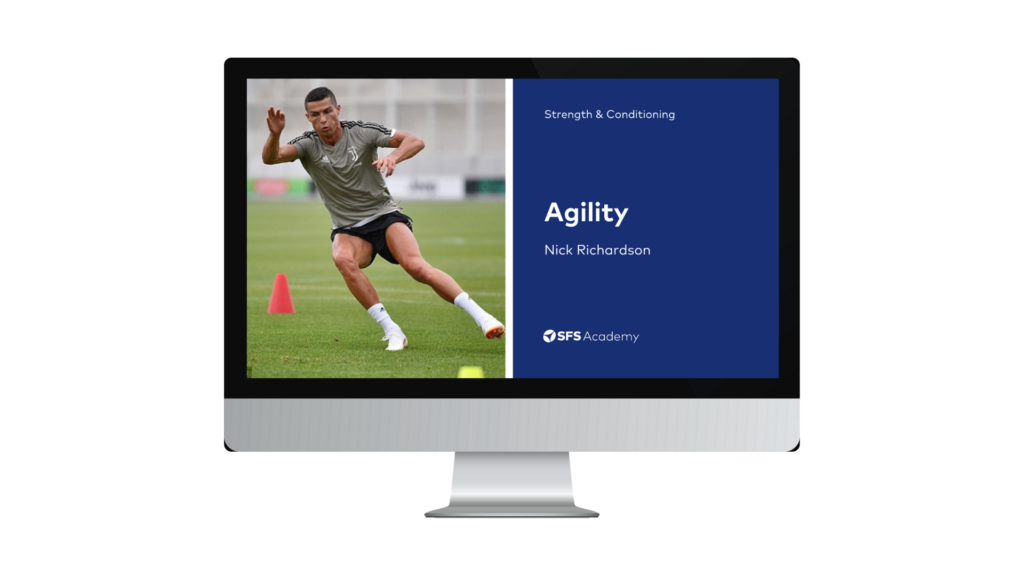The deadlift: Everything you need to know about this epic exercise
Whether you’re after gains in strength, power, speed, or improvements in body composition, deadlifting is the answer. Here’s your ultimate guide.
The deadlift: Your guide to a game-changer
“When you do other lifting exercises, like a bench press, for example, you’re not doing anything you might really do in real life. When are you ever going to have the need to lay on your back and push something in the air? Unless you’re giving your two-year-old flying lessons. The deadlift develops the muscles you need to actually carry something, like a bucket of water, those heavy grocery bags or your neighbour’s dining room table.” – Michelle Kennedy Hogan, author.
Arguably the truest test of total body strength, the deadlift is a multi-joint exercise that involves major muscle groups working in coordination to produce force and tension throughout the legs, hips, back, and torso.
With all the muscle mass involved, there’s opportunity to lift some of the heaviest loads possible, generating maximal muscular forces through the ground. Deadlifts provide an edge like no other that carries over to sprinting faster and jumping higher.
Whether you’re after gains in strength, power, speed, or improvements in body composition, deadlifting is the answer. It’s no coincidence that the deadlift consistently shows up in training the best and strongest athletes. It is an extremely effective exercise for anyone looking to get stronger and move better.
Deadlift benefits
There’s no denying the deadlift can deliver some incredible results, but many shy away from it. Why? Well, because with improper lifting technique, comes increased injury risk.
Although the deadlift appears very simple, it can be very challenging at the same time, as the discs of the lower back can be exposed to extreme compression forces with maximal efforts.
The important thing to understand is, there are no bad exercises, but rather bad technique.
When done properly, all the muscles of the posterior kinetic chain (i.e. calves, hamstrings, glutes, lumbar spine, upper back, and trapezius) are working together. With all this effort comes great responsibility, and for the deadlift to be safe and effective, it requires a blend of both control and grit.
The primary reason the deadlift can be a great exercise is that it can help develop an abundance of other exercises (e.g. cleans or snatches), movement patterns (e.g. squatting, lunging, bracing, pulling), and sport-specific skills or actions (e.g. jumping and sprinting).
The lift is unique, as there is no eccentric (lowering) muscle action before the concentric (upward) lifting motion, unlike the squat and bench press. This means there is no use of stored elastic energy provided by the stretch-shortening cycle – think of this as a spring, where muscles and tendons compress before quickly releasing, improving strength capabilities.
This is where the ‘dead’ lift earns its name — through the fact the weight is lifted from a dead stop position — and why it’s so functional for both everyday life and sport. It directly transfers to lifting large objects off the ground or explosively taking off from a stationary position.
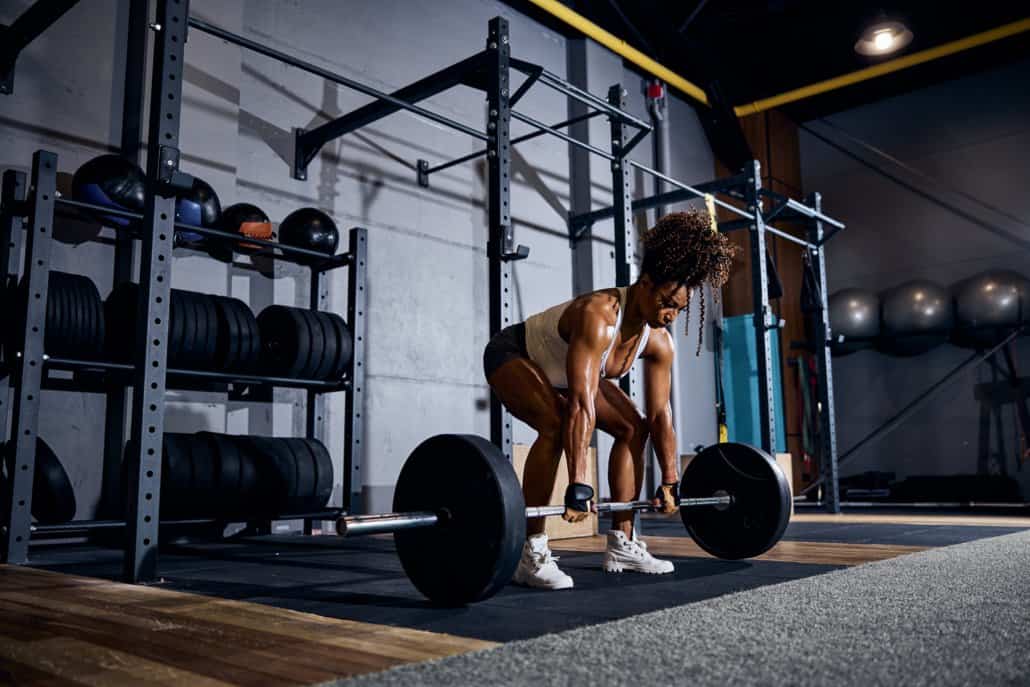
Deadlift form: Technique is crucial
Before anyone can experience the benefits of the deadlift, proper technique must be established and understood.
First, look to create awareness of the fundamentals related to deadlifting – these are the bedrock basics that centre around safety, simplicity, and consistency. It all begins with a proper setup:
- Stance – keep your feet hip-width apart with toes pointing straight ahead.
- Grip – your hands should be shoulder-width apart, with your arms hanging directly over them. The non-negotiables around the deadlift require gripping the bar tight with purpose, thumb around the bar and knuckles down. Alongside the narrow stance, this wider grip ensures the knees and knuckles are not competing for space during the lift.
- Body position – be sure to keep your back flat, with your hips above your knees, and shoulders above your hips. The head, neck and chest should always angle in the same direction – wherever the chest points, the eyes follow. It’s often helpful to find a focal point on the ground about three metres in front and keep your eyes affixed and head stable throughout.
Keep in mind that these positions are not set in stone but rather starting points, with adjustments always an option based on your individual capabilities.
With proper setup covered, we can now get into the nuts and bolts of how to move with the bar:
- Bar path – straight up and down, keeping the bar in contact with the body throughout. This is generally pretty straightforward and quick to catch.
- Bracing – engage your torso, maintaining pressure through the core to support the spine. This can be as simple as contracting the abs as if you are receiving a punch. If that doesn’t do the trick, front planks may help to feel the engagement needed. If all else fails, using a lifting belt so there is something to push the abdomen against helps learn how to brace the core.
- Foot pressure – keep an evenly distributed ‘tripod’ foot contact, stable from mid-foot to heel with an active arch maintaining full foot contact with the ground. There are multiple ways to learn this – you can aim to grip the ground with your toes to engage the arch, or favour the ball of the foot and outer rim of the shoe. Ultimately, what matters most is that the foot remains stable and the arch does not crash.
How to deadlift, continued
Take it from the Top
Another token to consider when setting up for success is learning the deadlift from the top-down.
- Start with the standing lockout position:
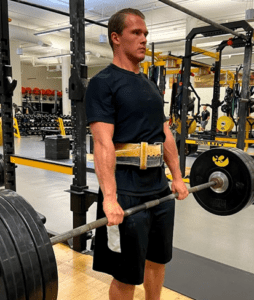 Hold the weight strongly through the shoulders and upper back, chest out, eyes fixed out in front, brace through the abdominals and engage the glutes (this is called being ‘stacked and packed’).This is an important position to master and experience, as well as a simple place to start.
Hold the weight strongly through the shoulders and upper back, chest out, eyes fixed out in front, brace through the abdominals and engage the glutes (this is called being ‘stacked and packed’).This is an important position to master and experience, as well as a simple place to start. - We’re always stronger when lowering weights to the ground than lifting them up. So, controlling the bar down slowly helps feel the muscular tension necessary to deadlift off the ground.To do this, starting in the lockout position, push the hips back and once the hips stop traveling backwards and the bar has passed the knee, drop the hips until the plates reach the floor.This is where it’s most important to stay true to our bar path, bracing, and foot pressure, as this is the moment in the lift when the back can round, and injury risk rises dramatically.
Deadlifting Off the Floor
Using the fundamentals above, we can establish a consistent setup routine for how to approach the bar and begin a deadlift.
Here’s my process:
- Begin by standing with the bar directly over the shoestrings, approximately 4cm away from the shins. This helps to ensure that when the legs load into position, the shins slightly contact the bar without the plates having to shift or roll on the floor, keeping the bar directly under the shoulders.
- Grip the bar strongly, with tension through the arms and upper back.
- Take a big breath in to brace and hold.
- Load the hips into position between the knees and shoulders.
- Lift the chest, with the neck and head aligned, finding a focal point 3m out in front.
- Feel for the tripod foot pressure and maintain tension throughout the body.
We Have Liftoff
When lifting the bar off the ground, think of pushing your legs into the floor.
Remember, that initial push is the most challenging, so stay braced and confident in your grip. As the legs extend, the knees and hips shift back slightly, head and chest rise together, and the bar path should remain vertical and tight to the shins.
When the bar clears the knee, push the hips forward and continue lifting the chest into the upright, lockout position (shoulders back, chest out, torso stacked with hips engaged).
Exercise progressions: Learning to move
The deadlift is an awesome exercise, but in order to lift the heaviest loads possible, patience and progression is important.
For those with little experience using free-weights, employing a progression plan can help improve movement skills and overall body awareness with a barbell before getting into the heavy stuff.
As a hybrid exercise that involves both hinging at the hips, as well as squatting through the hip, knee, and ankle, the deadlift can benefit greatly from learning how to hinge and squat separately.
The Hinge
The Romanian deadlift (RDL) targets the hips, hamstrings, and low back as a pure hinge exercise. It’s a great learning tool for the deadlift because the setup and barbell position are the same. It offers exposure to similar skills and demands without the complexity and stress of squatting down to the floor.
The RDL starts with the same stance and grip, standing tall and strong, shoulders back, chest up, eyes forward, and stacked with the torso and hips engaged. Maintaining a rigid spine, braced torso, tripod foot pressure, and tight-bodied bar path throughout.
For the descent of the RDL, the movement is initiated with pushing the hips back. The back stays extended, rigid, and flat throughout, and the barbell remains in contact with the body, sliding down the thighs as the hips travel back.
Where the deadlift requires a greater range of motion at the knee, the RDL simply involves a constant slight knee bend throughout the lift, keeping the legs long and hips high.
The Squat
With the hamstrings, hips, and low back targeted through the RDL, the squat — arguably the king of leg development — can also be a great exercise in developing a solid deadlift.
The squat targets hip and ankle mobility, as well as strength through the quads and hips, which will help when deadlifting massive loads from the floor.
We won’t cover the ins and outs of the squat, but here’s a great source if you need some advice.
What NOT to do
The piece that enables a safe and effective deadlift over any other factor is proper loading.
This means never sacrificing technique for load – for first timers, keep the loads extremely light, using 5-10 kg training plates to learn the basics (stance, grip, body position, and bar path).
Also, to help maintain quality reps, avoid trying to do more than six reps in a given set.

Here are some of the other most common errors made when deadlifting:
- Squatting too deep – stay strongest with your hips above your knees.
- Not squatting deep enough – keep your hips below your shoulders.
- Rounding the back – lift with your legs and always maintain correct posture.
- Knees crashing together – push your knees towards your forearms and maintain that tripod foot pressure.
- Leaning back (hyperextending spine) at the finish – contract your abs to keep the ribs from flaring out, and glutes to keep your hips and back in a solid lockout position.
- Jerking the arms to start – create tension and remove any slack in your arms, apply pressure and accelerate the bar.
- Bouncing the plates off the ground – allow the plates to come to a dead stop prior to each lift off, but always maintain grip and tension.
Deadlift variations
The Sumo deadlift
The sport of powerlifting is booming, and with the primary goal of lifting as much weight as possible in the most efficient manner came the evolution of the sumo-style deadlift.
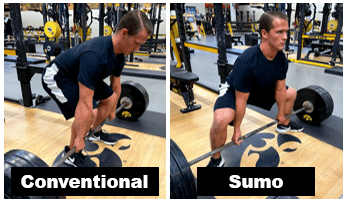
Up until now, the deadlift referenced has been the hands-outside-the-legs, ‘conventional’ deadlift. There is an alternative deadlift known as the ‘sumo deadlift’ that has a much wider stance, where the knees and toes angle outward, and the bar is gripped between the legs.
Major differences between conventional and sumo deadlifting:
- Conventional requires more ankle mobility, targeting the calf and low back more than the sumo stance.
- Sumo deadlifting requires more hip mobility, targeting the quadriceps more than the conventional deadlift.
Advantages of the sumo deadlift:
- The distance to lockout is shorter.
- Decreases forces on the spine because of the more upright posture, keeping the bar closer to the hips.
Both types have their time and place, as both are effective in getting stronger throughout the lower body, hips and torso.
Ultimately, it comes down to your needs and goals (e.g. target muscles, personal preference based on size and limb length, or maximal loads). Either way, technique and safety should always reign supreme, with exercises being adapted to each individual.
Hexagonal bar deadlift
The development of the hexagonal (hex) bar has given rise to another variation of the deadlift that aims to reduce injury risk by allowing a more advantageous posture and distribution of load). 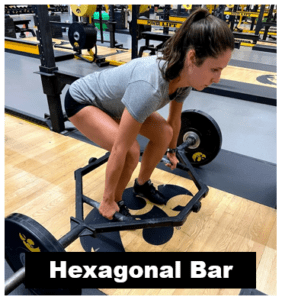
Rather than a straight barbell that is held in front, the athlete stands inside of a hexagonal frame with handles positioned at the sides. This generally allows for a movement pattern that is more like a squat, since the knees are not restricted to flex and push forward (there’s no barbell there to avoid). With this setup, the hex bar allows for greater peak force, velocity, and power.
In the battle of barbell versus hex bar, it’s not a question of which is better or worse. Instead, it’s more important to figure out which bar is most effective in working towards your training goals.
If the goal is to work towards more advanced power-building weightlifting exercises, the barbell deadlift may be best.
If lifting the heaviest loads possible and reducing stress on the low back is important, the hex bar is your answer.
The greatest limitation with the hex bar is that the grip width is fixed and depends on the size of the bar. Athletes that are bigger or smaller in stature may be placed in an uncomfortable grip position that is either too wide or narrow. This is especially common with smaller females who are using hex bars built for larger individuals and have handles that are over 60cm wide.
Next-level tips and tricks for deadlifting
As technique is mastered and loads increase, there are options available that maximise how much you can lift. Being challenged in new and different ways helps strength gains.
Grip strength is oftentimes a limiting factor when deadlifting.
Here are a few ways to increase grip strength:
- Alternated grip – one hand under and the other over the bar.
- Hook grip – pin the thumb against the bar with the rest of your fingers (this is a more specialised modification for a weightlifting athlete preparing for maximal cleans or snatches).
- Lifting straps – wrist straps go around the barbell and are held in place by the hand, pulling on the wrist for added support. This becomes more important if lifting with budget barbells since the knurling typically isn’t as rough.
Wearing a lifting belt is another potential strategy to help increase load and support a more stable and rigid torso.
Other deadlift variations
Variations allow for a different challenge, further overall progress, and ultimately maximise the benefits of deadlifting.
Here are some of my favourite deadlift variations:
- Deficit deadlifts – stand on a 5-10cm block or plate to provide overload to the liftoff.
- Elevated deadlifts – raise the starting point of the lift by placing the plates (or bar) on blocks (or a rack) to reduce the range of motion required.
- Tempo’d deadlifts – controlling the barbell down to the floor after lockout for 4-6 seconds for increased time under tension and improved control.
- Pausing – holding the lift at mid-shin or just above the knee can really improve strength and posture in these challenging sticking points.
- Power deadlifts a.k.a ‘Clean Pulls’ – moving a moderate load as fast as possible can help develop maximal power.
- Snatch grip deadlifts – Adjusting grip width to a wider position will increase the challenge to both grip as well as the upper back.
- Staggered stance with a hex bar – Using a staggered stance is great for targeting each leg separately.
The deadlift: Take-homes
When first implementing the exercise in a structured program, aim to deadlift a safe and appropriate weight twice per week, with five sets of five repetitions. This has shown to be an effective strategy at improving strength and explosive power.
Incorporating the deadlift into a training program requires appropriate planning and navigation. If the time is taken to learn proper technique, the deadlift can be a very efficient and effective exercise for anyone aiming to get stronger.
[optin-monster-shortcode id=”czosk0qsqzzsryj6gwot”]

